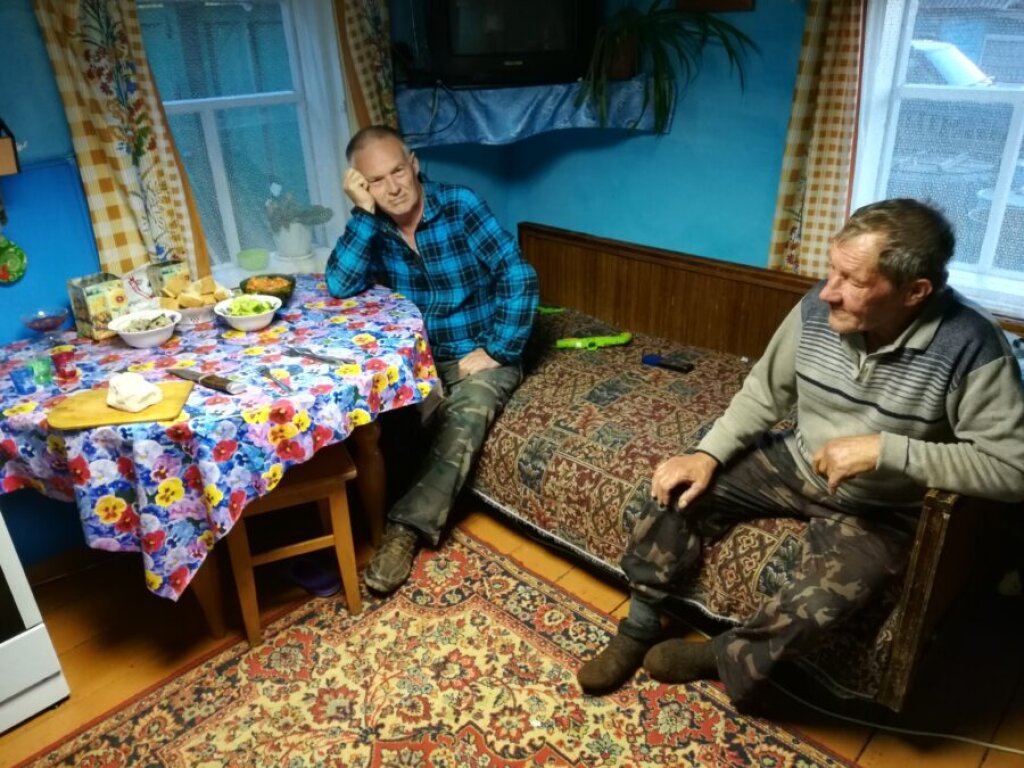We at the Jordan Center stand with all the people of Ukraine, Russia, and the rest of the world who oppose the Russian invasion of Ukraine. See our statement here.
Vasilina Orlova is a sociocultural anthropologist interested in the materialities of affect, Socialist visions of the future, and the contemporary manifestations and endurances of such visions. She has a Ph.D. in Anthropology from the University of Texas at Austin. She has written books in Russian, the latest being The Anthropology of Everydayness (Nookratia, Moscow, 2018). Her research was supported by the Wenner-Gren Foundation for Anthropological Research.
Smoothly functioning infrastructures are unnoticeable; they attract attention only when they break down. However, even where infrastructures do not function as intended, they do not necessarily stop working altogether. Instead, they start to function in unexpected ways.
I had the opportunity to learn this lesson in the village of Anosovo, Eastern Siberia, the main site of my fieldwork. As they begin to malfunction, infrastructures not only facilitate engagement, but also produce an affect. Thus one “broken road” [razbitaia doroga] became a site around which belonging and relating unfolded. Infrastructure acquires its affective capacity precisely because it malfunctions. Such affect can include components of anger and annoyance, but also a sense of unity, sociality, camaraderie, and feelings of belonging to a group.
Anthropologists have long been fascinated by the affective power of infrastructures. Brian Larkin, Alice Street, Penny Harvey, Hannah Knox, Caroline Humphrey, and many others are interested in the political entanglements, enchantments of modernity, dreams and visions enabled through grandiose and modest infrastructural projects alike.
The “broken road” I encountered in Eastern Siberia produced the affective cycle of the construction project refusing to come into being. As a general rule, Soviet infrastructures, their unfulfilled nature notwithstanding, remain crucial throughout Russia. “Ruins” endure; little can be done with them beyond ruining them further. New structures meant to supplement old ones do so only partially and inadequately, to the point that we might see them as parasitizing on past infrastructures rather than truly replacing them.
Capitalist firms that have replaced the “town-forming,” timber-harvesting socialist enterprise in Anosovo, for example, appropriated and (mis)used buildings and sites from Soviet times like garages, checkpoints, and storage facilities. Despite this continuity of legacies, the firms eschewed any social obligations. “Well, we do not represent the state here,” a timber manager grudgingly told me.
The CEO of the new, capitalist enterprise campaigned to become a member of regional parliament on the promise to build a road to Anosovo. He was elected, but the promise remains unfulfilled and the problem of the road persists. Among villagers, the broken road sparked disagreements where interlocutors' positions corresponded to differences in worldview, so that, in effect, the malfunctioning infrastructure generated intensities and contributed to identity production. In the half-joking framing of Anosovian Sergei Klyuev, “This is not a bipartisan issue. This is a harsh divide. The party of progressivists against the party of reactionaries or obscurantists [mrakobesy].”
“Progressivists” hoped that, with the advent of a smooth, good, passable, “unbroken,” mended road, life would “fall into order.” Skeptics objected. Mrakobesy—who were apparently also optimists—tended to see a good side to the status quo. While progressivists were strongly pro-road, mrakobesy, asked whether there was really nothing to be lost if the town acquired a smooth road.
Progressivists are easy to understand, but every mrakobes is a character in his or her own right. For instance, one of the road dissidents, Alexei Yakhontov (60 years old), is a known brawler in the village. Alexei gained notoriety in Anosovo as a young man riding his horse into the village club. “Caligula,” Sergei Klyuev called him. I had heard about Alexei before I met him—his fame preceded him, as it were. As the conversation progressed, I asked Alexei how it had happened that he drove his horse into the village club. “On a bet,” he replied, lighting a cigarette. He was sentenced to fifteen days for hooliganism. “It’s okay,” he now says. “What could have been done [Chto sdelaesh']?”
When a group of dark-skinned, skinny young men appeared in the village, Alexei was on the lookout. Anosovians called them “Gypsies.” They rode motorbikes and were selling blankets. While some villagers looked at the wares, Alexei waved his hand: “Go away! You will not profit from us [nichem vy ne pozhivites’ zdes’].” Alexei was apprehensive about strangers in Anosovo. If the price of fewer strangers was a broken road, that was fine with him.
Time and time again during my fieldwork, the road revealed itself as a site where malfunctioning became a form of functioning. The impassability of the road became its attribute; “brokenness,” functionality. For some, the road's very “brokenness,” which prevented strangers from accessing the village, was a major advantage. The sense of belonging emerged alongside the feeling that outsiders do not belong. Resentment, entangled with anger and coupled with hope for the future—against all reason—and the plain need to have the road in a passable state, constituted a mix of charged emotions. Hostility to the racially different other, as a newcomer or outsider, was a caustic element in this varied mixture.
The broken road and the disconnectedness that it engendered contributed to the formation of identities and built a sense of belonging; thus malfunctioning infrastructure carried affect and became affective. The anger, sadness, self-pity, and feeling of being cast aside are components of an affect that emerges because the road is malfunctioning—or functions in other ways than how it “should.” Malfunctioning infrastructures are potent producers of affect because they require intense engagement, as opposed to more or less automatic navigation.
The road to Anosovo figured in the production of identities and the organization of socialities, becoming a site where belonging and relating unfolded daily. When infrastructure malfunctions, its every hiccup becomes a center of a little unfolding world, a conversation, a sociality, or an identity-formation moment as people come together or break apart into certain “factions” in an effort to overcome it, fix it, or simply work around it.
When concrete solutions are out of reach (e.g., business cannot afford to fix the road, and the state pays it no attention), the feelings accompanying the problem range from anger, hope, dreams, and fantasies of the future, all the way to nonchalance—a cheerful refusal to care too much. In this way, the broken road features in everyday life as it unfolds in myriad ways—many of them difficult to account for. People make numerous transactions around the road, becoming, in a way, part of the infrastructure, facilitating its functioning while meeting their own goals.
These functions of the malfunctioning road—a political issue and a device creating socialities—demonstrate that malfunctioning infrastructures facilitate an affect of belonging that accompanies socialities emerging for communal problem solving. The affect associated with the road is particularly strong because of a dysfunctional materiality that demands to be fixed, surmounted, or otherwise dealt with. The malfunctioning piece of infrastructure becomes an arena for performing affects of dissatisfaction, but also the satisfaction and pride that surmounting the road evokes.
Malfunctioning infrastructures are no longer as “invisible” or unnoticeable as functional ones (as a billboard in Austin, Texas puts it, “the best internet is the internet you don’t notice.”) By contrast, malfunctioning infrastructures become hyper-visible, particularly tangible, and uber-noticeable: they generate affect. Hence, some of the most affective infrastructures are precisely malfunctioning ones. It is not that smoothly functioning infrastructures are unaffective, just that they might reveal affect less readily than their non-functional counterparts.
Malfunctioning arrests the process of using of the infrastructure, forcing people to focus on it and engage with it more intensely. Malfunctioning infrustructures, far from reducing feelings of camaraderie, relationships, and a sense of belonging, actually seem to intensify them. While it may not be possible to hierarchize infrastructures based on their affective powers, given the multiplicity, difficulty of discernment, and idiosyncratic nature of some of the experiences and sensations they evoke, infrastructures tend to be particularly affective when a breakage, slippage, or interruption is introduced into their circuits.
Read the fuller version of this work, exploring fleeting socialities that the malfunctioning infrastructures generate and the language ideologies around the road in Sibirica.
On “cheerful nonchalance,” read the author’s forthcoming article in Slavic Review (Vol. 80, 2022).




